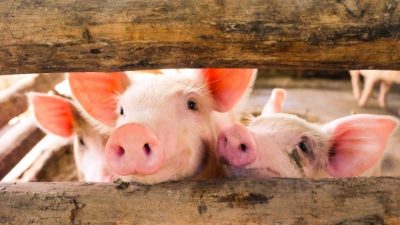Domesticated Animals

Animal Sentience
One of the qualities that develops with a nervous system is “sentience.” Eighteenth century philosophers used the concept to distinguish between the capacity to think and to feel. We sentient creatures have an emotional life. We can feel fear and pain. We can suffer. We can play and feel affection. Anyone who has spent even a short time around animals knows that they share these experiences with us. Even if you have only viewed animals on-screen, you will have seen them display concern and compassion for each other. They share these traits with us and do not simply live to please us or for our amusement and use.
The concept of anthropocentrism, which suggests that human beings are the most important life-form on the planet, is as outdated as the idea that the sun revolves around the Earth. To justify our abuse of animals, we put humankind at the pinnacle of life on Earth and make mere objects of other life-forms. This attitude lies at the root of many human problems. Killing other sentient creatures diminishes us. It is a attempt to place ourselves outside and above the web of life.
When animals are “things,” they can be owned and used as the owner sees fit. Endless campaigning to “improve” the abuse and refine the killing do not change the basic facts. Regardless of the superficial improvements in the raising or transportation of an animal, their lives are cut short, they are slaughtered.
Livestock and the Environment
Our reluctance to consume plant foods (which are superior sources of nutrition) as our main diet is an ecological and economic disaster. The rain forests of the Amazon basin are one of the most important buffers to the rise in greenhouse gas emissions, and they are under direct threat from increased deforestation for growing animal feed and manufacturing biofuels. It is estimated that cattle ranchers and soy farmers are some of the biggest contributors to destruction of the forests.
By the year 2050, we will need to feed the projected nine billion people who will live on the planet, and our food supply will have to be sustainable—or we will die. Those foods that use soil and water most efficiently need to be the primary focus of a healthy diet. It should be obvious that we will need to stop cutting down forest land and, instead, use the already cleared land to grow food for humans, not animals. If this is not done, there will be no food security.
When we look at the effect of our food choices on climate change, the solution is obvious. Meat and all forms of animal agriculture are the most significant direct contributor to the problem. Livestock production accounts for up to 70 percent of all agricultural land use and 30 percent of the land surface of the planet. According to the United Nations, livestock contributes 87 percent of greenhouse gases and is a major contributor to both land and water degradation. The bottom line is that if you care about saving the environment and still have meat, fish, dairy, or eggs on the menu, you need to think again.
Zoonosis
When we force chickens, cattle, and pigs into cramped and crowded quarters, they breed new strains of viruses that jump species. Infectious diseases that start in animals and can be naturally transmitted to humans are called zoonosis. It is estimated that 61 percent of all known pathogens that infect humans are zoonosis, including many serious diseases, such as the Ebola virus disease, salmonellosis, and influenza. We know factory farming presents both direct and indirect health challenges to us all. Even if we were only focused on the direct effect on human health, we should be concerned.

